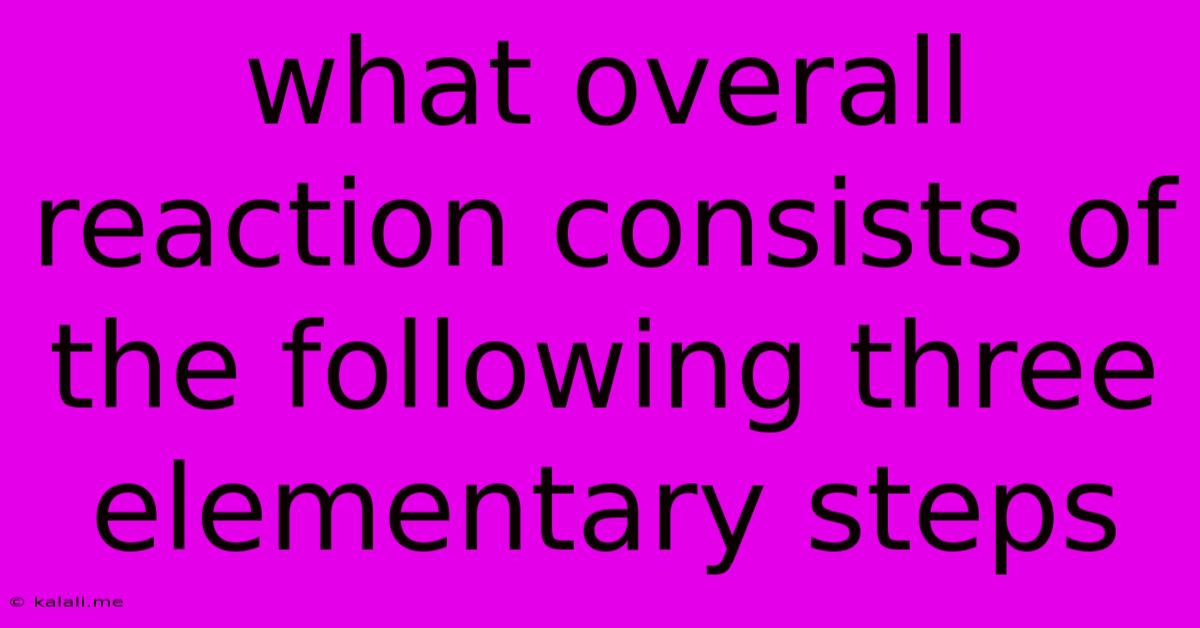What Overall Reaction Consists Of The Following Three Elementary Steps
Kalali
Jun 13, 2025 · 3 min read

Table of Contents
Deconstructing Complex Reactions: Understanding Elementary Steps and Overall Reactions
This article delves into the fascinating world of chemical kinetics, specifically focusing on how multiple elementary steps combine to form a complex overall reaction. We'll explore the concept of elementary steps, how they're identified, and how to determine the overall reaction from a given series of elementary steps. Understanding this process is crucial for predicting reaction rates and mechanisms. This guide provides a clear, step-by-step approach to analyze complex reactions and determine their overall reaction equation.
What are Elementary Steps?
Elementary steps, also known as elementary reactions, represent the most fundamental individual steps in a complex chemical reaction. They depict the actual molecular events occurring during the reaction. Unlike overall reactions, which may appear as a single, simplified equation, elementary steps show the exact molecularity – the number of molecules involved in a single collision – of the reaction. They are described by their molecularity, which can be unimolecular (one molecule), bimolecular (two molecules), or rarely, termolecular (three molecules). Termolecular steps are less common due to the low probability of three molecules simultaneously colliding with the correct orientation and energy.
Identifying Elementary Steps
Identifying elementary steps requires understanding the reaction mechanism. This often involves experimental data, such as reaction rates under varying conditions and the identification of reaction intermediates. Reaction mechanisms are often proposed based on experimental evidence and then tested through further experiments.
Determining the Overall Reaction from Elementary Steps
To find the overall reaction, we need to add the elementary steps together, much like solving simultaneous equations. However, there's a catch: any species that appears on both the reactant and product sides of the individual steps (intermediates) should cancel out.
Let's illustrate this process with a hypothetical example. Consider the following three elementary steps:
Step 1: A + B → C (fast) Step 2: C + D → E (slow) Step 3: E → F + G (fast)
To determine the overall reaction, we sum the three steps:
A + B + C + D + E → C + E + F + G
Now, we cancel out the species appearing on both sides (intermediates C and E):
Overall Reaction: A + B + D → F + G
Notice how the overall reaction simplifies the complex series of steps. The intermediate species, C and E, are not present in the overall reaction equation. The slow step (Step 2, in this case) often determines the rate-limiting step of the overall reaction. Understanding the rate-determining step is vital in predicting the overall reaction rate.
The Importance of Understanding the Mechanism
It is important to emphasize that simply adding the elementary steps is insufficient to determine the rate law of the overall reaction. The rate law is determined by the rate-limiting step (slowest step) of the mechanism. The order of reaction for each reactant in the overall rate law depends on the stoichiometry and the mechanism (whether the elementary steps are unimolecular or bimolecular).
Conclusion
Understanding the relationship between elementary steps and overall reactions is crucial for a comprehensive understanding of chemical kinetics. By carefully analyzing the individual steps and identifying intermediates, we can successfully determine the overall reaction equation. Remember that the rate-determining step and its molecularity significantly influence the overall reaction rate and its dependence on reactant concentrations. This analysis allows for a deeper understanding of reaction mechanisms and reaction dynamics.
Latest Posts
Latest Posts
-
20 Is 60 Of What Number
Jun 13, 2025
-
6999 Rounded To The Nearest 10
Jun 13, 2025
-
What Is The Factors Of 89
Jun 13, 2025
-
Every 4 Way 2 Lane Intersection Has How Many Conflict Points
Jun 13, 2025
-
Buying And Selling Goods And Services Electronically Is Called
Jun 13, 2025
Related Post
Thank you for visiting our website which covers about What Overall Reaction Consists Of The Following Three Elementary Steps . We hope the information provided has been useful to you. Feel free to contact us if you have any questions or need further assistance. See you next time and don't miss to bookmark.